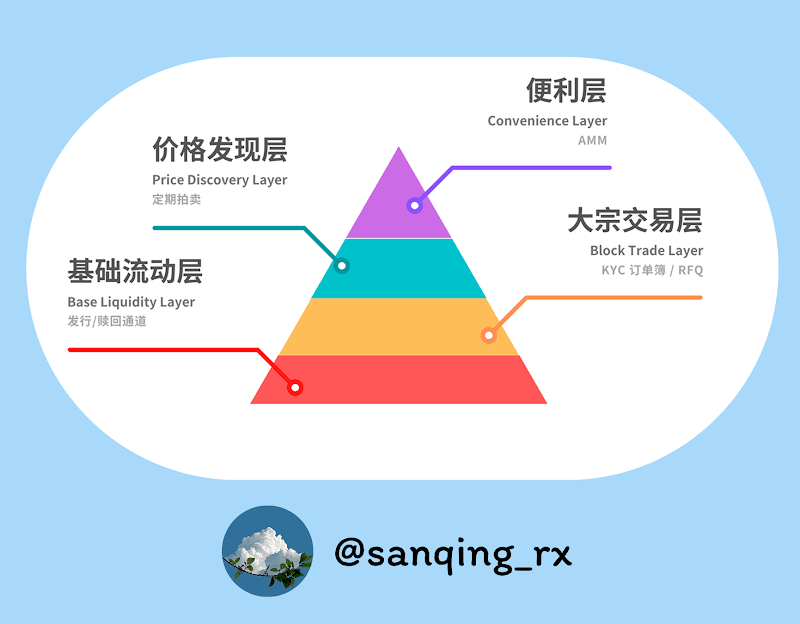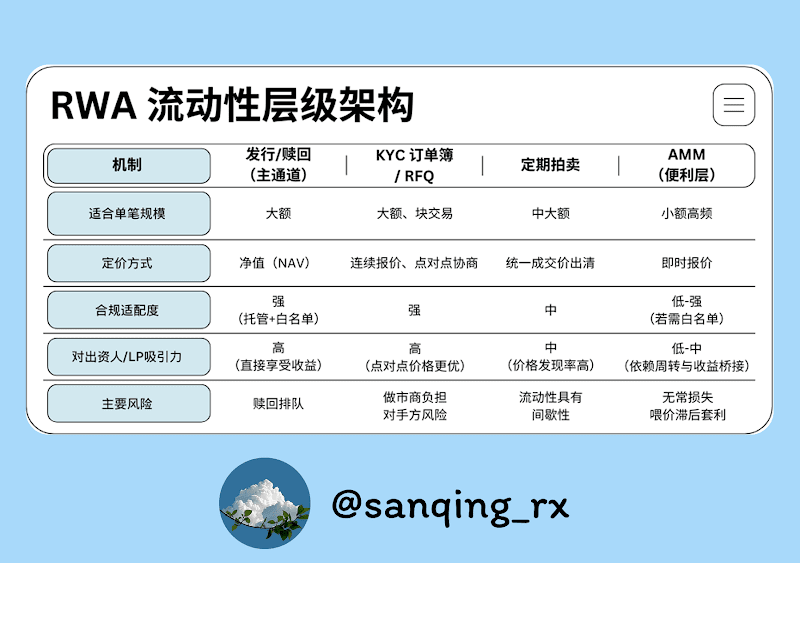Original title: (Where should AMMs stand in RWA?)
Original author: @sanqing_rx, core member of RealtyX DAO community
Introduction: Bridging the liquidity gap of RWA
Real World Assets (RWA) are becoming a key narrative for Web3's mainstream adoption. However, bringing trillions of dollars’ worth of real assets on-chain is just the first step; the real challenge lies in building efficient and robust secondary market liquidity for them. Automated Market Makers (AMMs) are naturally expected to play a foundational role in DeFi, but can they be directly replicated in the world of RWA?
Summary (three-sentence overview)
· Conclusion: The current mainstream AMMs (concentrated liquidity, stablecoin curves, etc.) are not suitable to serve as the 'main market' for RWA. The biggest obstacle is not the curve model, but the economic model of LPs (liquidity providers) which cannot sustain in a low turnover, strong compliance, and slow pricing RWA environment.
· Positioning: Issuance/redemption, KYC order book/RFQ, periodic auctions should be set as the 'main routes' for RWA liquidity; AMMs should retreat to the 'convenience layer', only handling small, daily, and convenient secondary trading demands.
· Method: Through a combination of 'narrow band market making + Oracle Slip-Band/Hook + yield bridging', truly transmit RWA's native income (such as interest, rent) to LPs, supplemented by sound risk control and information disclosure.
I. AMMs should not become the 'main market' for RWA
RWA seeks predictable, measurable, and settleable financial main arteries. Although the continuous quoting AMM mechanism is highly innovative, it faces three inherent challenges in most RWA scenarios: naturally low transaction volume, slow information heartbeat, and extended compliance pathways. This makes it exceptionally thin for LPs to rely solely on trading fee returns, while also exposing them to the risk of impermanent losses.
Thus, our core viewpoint is: AMMs should not bear the responsibility of being the 'main market' for RWA, but should serve as the 'last mile' of liquidity. Its role is to allow users to conveniently exchange small assets anytime and anywhere, enhancing user experience, but the core functions of large transactions and price discovery must be entrusted to other more suitable mechanisms.
II. Why can AMMs thrive in the crypto-native world?
To understand the limitations of AMMs in the RWA scenario, one must first understand the cornerstone of their success in the crypto-native world:
● Continuous trading: A 7x24 hour global market, combined with permissionless cross-market arbitrageurs, ensures that any price difference will be instantly eliminated, creating continuous trading activity.
● Highly combinable: Almost anyone or any protocol can participate in liquidity provision or arbitrage without thresholds, forming a strong network effect and self-reinforcing flow.
● Volatility is business: High volatility brings a large amount of trading demand and arbitrage opportunities, and the resulting trading fees give LPs the chance to 'outperform' impermanent losses.
When we try to replicate these three points in the RWA field, we find that the entire foundation has changed: transaction frequency has significantly decreased, pricing heartbeat is extremely slow, and compliance thresholds have risen sharply.
[On-site explanation | Pricing heartbeat]
'Pricing heartbeat' refers to the 'frequency of reliable price updates', which is key to understanding the differences between RWA and crypto-native assets.
· Crypto-native assets: Typically have a heartbeat on the order of seconds (exchange quotes, oracle price feeds).
· Most RWAs: Typically have a heartbeat on the order of days or even weeks (fund net value updates, property valuations, auction closing prices).
Assets with slower heartbeats are less suitable for long-term deep continuous quoting pools.
III. In the RWA scenario, LPs' economic calculations are not balanced.
The 'annualized return feeling' of LPs' invested capital mainly depends on three factors: transaction fee rates, the turnover strength of funds within the effective price range, and the annual repetition of trading rhythms.
For RWAs, this calculation is difficult to balance because:
● Turnover rate is generally low: 'Funds stagnant in the pool' are rarely 'activated' by high-frequency trading, leading to scarce fee income.
● Opportunity costs are too high: External markets offer considerable interest or risk-free rates. LPs holding RWA assets directly (if possible) with the same principal is often more cost-effective than providing liquidity.
● Risk-reward imbalance: In the context of low fee income, LPs also have to bear impermanent loss (relative to holding assets unilaterally) and the risk of being 'preyed upon' by arbitrageurs due to price feed delays.
Overall, LPs' economic model is naturally at a disadvantage in the RWA AMM context.
IV. Two major structural frictions: Pricing and compliance
In addition to the economic model, two structural issues hinder the application of AMMs.
· Mismatched pricing rhythms: RWA's net asset value/valuation/auction has a 'slow heartbeat', while the AMM provides instant tradable quotes. This time difference gives those with the latest information a huge arbitrage window, allowing them to easily 'exploit' the price difference of LPs who are unaware.
· Compliance cuts into combinability: Compliance requirements such as KYC, whitelists, transfer restrictions, etc., lengthen the paths for funds to enter and exit, breaking the DeFi 'everyone can participate' Lego block model. This directly leads to fragmentation of liquidity and insufficient depth.
· Cash flow 'pipeline project': Cash flows such as RWA's interest or rent must either be reflected through net asset value increases or require direct distribution. If the AMM/LP mechanism does not properly design the capture and distribution path of income, LPs may not receive this cash flow they are entitled to, or may be diluted in the arbitrage process.
V. Applicable boundaries and practical cases
Not all RWAs are incompatible with AMMs; we need to categorize and discuss them.
· More friendly: Short-duration assets with daily updated net values and high price transparency (such as money market fund shares, short-term government bond tokens, interest-bearing certificates). These assets have clear central prices and are suitable for providing convenient exchange services with narrow band AMMs.
· Less friendly: Assets that rely on offline valuations or infrequent auctions (such as commercial real estate, private equity). These assets have a slow heartbeat and severe information asymmetry, making them more suitable for order books/RFQ and periodic auction mechanisms.
Case study: The arbitrage window of Plume Chain Nest
· Background: The nALPHA and nBASIS tokens from the Nest project have AMM pools on Curve and native Rooster DEX. Initially, their redemption process was very fast (about 10 minutes), but the price update frequency of the tokens was about once a day, sometimes slower.
· Phenomenon: Due to daily updates of net asset value and AMM's 'second reporting', when new net values are announced, AMM prices fail to keep up in time, resulting in an arbitrage window of 'buying low on DEX → immediately applying for redemption from the project party → settling at the updated higher net asset value'.
· Impact: Arbitrageurs profit while AMM LPs bear all impermanent losses, especially those LPs providing liquidity in more deviated price ranges, suffering heavier losses.
Review and repair suggestions:
● Review: The root cause of the problem lies in the mismatch of pricing heartbeats, while the protocol lacks necessary risk control barriers and order diversion mechanisms.
● Repair suggestions:
- Order diversion: AMMs only handle small transactions (as explained below), while large orders are forcibly directed to RFQ or issuance/redemption channels.
- Price following: Using the 'Oracle Slip-Band + Hook' mechanism, provide liquidity only within a narrow range of ± of the latest net asset value, automatically migrating the price band or temporarily increasing the fee rate when the net value updates.
- Risk control barriers: Set thresholds for oracle freshness, price premium/discount circuit breakers, and switch to auction or redemption-only mode on significant valuation adjustment days.
- Information disclosure: Establish a public dashboard displaying premium/discount distribution, oracle status, redemption queue, etc., allowing LPs to make independent decisions.
VI. Four parallel 'liquidity skeletons'
A mature RWA market should have a multi-layered liquidity structure.


[On-site explanation | 'AMM only does small amounts']
· Positioning: Treat AMMs as the 'last mile' convenience trading layer, handling everyday small orders and asset adjustments.
· Practice: At the front-end routing level, for orders exceeding a specific threshold (e.g., a single transaction > 0.5%-1% of the pool TVL), force guidance to RFQ, order books, or issuance/redemption channels. The core responsibility of AMMs is to make the user experience of 'exchanging a little' smooth, rather than to absorb the impact of large transactions.
VII. Refinement operations: The three axes to effectively utilize RWA AMM
To enable AMMs to effectively play their role in the 'convenience layer', three things need to be done:
1. Narrow Band Market Making (Concentrated Liquidity)
Provide liquidity only within a very narrow range around asset net value. This can greatly improve capital efficiency and reduce the time window for liquidity to be 'stuck at old prices' and subject to arbitrage.
2. Price Following and Self-Protect (Oracle Slip-Band / Hooks)
This is a dynamic upgraded version of narrow band market making. Through orchestration of oracle and smart contracts, achieve automatic price following, and initiate protection mechanisms during market volatility.
[On-site explanation | Oracle Slip-Band and Hook]
· Slip-Band: A small segment of 'quote corridor' closely attached to the price fed by the oracle (such as net asset value). Liquidity is concentrated here.
· Hook: 'Programmable actions' embedded in AMM contracts. When the oracle price updates, it automatically triggers the Hook, migrating the 'slip band' to the vicinity of the new price, and can even temporarily raise rates to hedge risks.
Core goal: Avoid being stuck at old prices for long periods while retaining the convenience of small transactions.
3. Yield Bridging
It is essential to establish a clear mechanism to accurately allocate cash flows generated by RWA assets, such as interest and rent, to LPs in the AMM pool. The key is to clearly define the complete path of 'income into the pool → how to allocate shares → when it can be claimed' at the code level, allowing the sources of LPs' income to expand from solely trading fees to 'fees + native asset income'.
VIII. Conclusion: From 'continuous quoting' to 'predictable liquidity'
RWAs may not need the 7×24 hour price noise of blockchains; what they truly need is predictable, measurable, and settleable liquidity main arteries.
Let’s leave professional matters to professional mechanisms:
· Issuance/redemption, KYC order book/RFQ, periodic auctions - establish these main routes to enable price discovery and execution of large transactions.
· AMMs - position them in the 'last mile', focusing on providing small, smooth, and transparent exchange experiences.
When capital efficiency aligns with compliance realities, and we can no longer insist that AMMs bear the fantasy of being the 'main market', the on-chain secondary liquidity ecosystem for RWA can become healthier and more sustainable.
This article is from a submission and does not represent BlockBeats' views.




